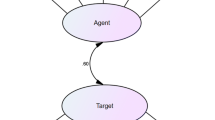Abstract
Despite the great need for assessment of the adaptive and defensive style of adolescents, there are few instruments available to assess these characteristics. We assessed Vaillant's defense hierarchial model in adolescents, using Bond's self-report questionnaire (DSQ) for adults adopted for adolescents. In all cases, the factor structure in adolescents differed from adults, which may represent a manifestation of development.
Similar content being viewed by others
References
Vaillant GE:Ego Mechanisms of Defense, a Guide for Clinicians and Researchers. Washington, D.C.: American Psychiatric Press, 1992.
Kohlberg L: Development of children's orientation towards a moral order (part I). Sequence in the development of moral thought.Vita Humana 6: 11–36, 1963.
Piaget J:The origins of intelligence in children, New York: International University Press, 1952.
Mc Cullough L: Toward reliability in identifying ego defenses: clinical techniques. in Vaillant, G. (Ed.),Ego Mechanisms of Defense: A guide for clinicians and researchers. Washington D.C.: American Psychiatric Association Press, 1992.
Vaillant GE: Theoretical hierarchy of adaptive ego mechanisms: a 30-year follow-up of men selected for psychological health.Archives of General Psychiatry 24: 107–117, 1971.
Vaillant G, Bond M, Vaillant C: An empirically validated hierarchy of defense mechanisms.Archives of General Psychiatry 43: 786–794, 1986.
Gleser GC, Ihilevich D: An objective instrument for measuring defense mechanisms.Journal of Consulting and Clinical Psychology 33: 51–60, 1969.
Bond M, Gardner, ST, Christian J, Sigal J: Empirical Study of Self-rated Defense Styles.Archives of General Psychiatry 40: 333–338, 1983.
Andrews G, Pollock C, Stewart G: The determination of defense style by questionnaire.Archives of General Psychiatry 46: 455–460, 1989.
Edwards AL:The Social Desirability Variable in Personality Research. Dryden, New York: Dryden, 1957.
Csikentmihaly M, Larson R:Being Adolescent. New York: Basic Books, 1984.
Blatt M, Feldman S, Ryst, E., Nasserbakht A, Steiner H: Age and gender differences in defense mechanisms.Scientific Proceedings, 39th Annual Meeting of the American Academy of Child and Adolescent Psychiatry, p. 95, 1992.
Author information
Authors and Affiliations
Rights and permissions
About this article
Cite this article
Nasserbakht, A., Araujo, K. & Steiner, H. A comparison of adolescent and adult defense styles. Child Psych Hum Dev 27, 3–14 (1996). https://doi.org/10.1007/BF02353442
Received:
Revised:
Accepted:
Issue Date:
DOI: https://doi.org/10.1007/BF02353442




